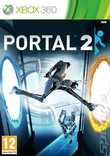Take a look around, and think about what you see around you. There's a chair, that you're presumably sitting on. You know how it feels, and how reacts - how it supports your weight. It works exactly as you'd imagine. There might be a cat, a PC monitor. Look through the window, at the world outside. If you threw a ball out of it, you know, pretty much, how it'd fly - in a downwards curve, governed by gravity and velocity. Everything you see, is governed by rules, and if you've been alive for more than a few seconds, you've got a pretty good idea of how everything interacts with each other, and the way the world works.
Now, forget everything you thought you knew.
In Portal 2, almost everything you've learnt up until now becomes useless. Here, the rules have changed. Not broken, not bent, but twisted into a pretzel, sprinkled with fiendish chunks of puzzle salt. A puzzle game at heart, played from a first-person perspective, Portal 2 sees you being locked into a series of test chambers as part of a devious "science" experiment - all you have to do is find your way out. Of course, things aren't as easy as they sound, as even getting to the door is a challenge in itself - not to mention the numerous things you'll have to do to unlock it, as you attempt to activate switches, reach higher platforms, and, er, laser laser receptacles. And to make things that much more interesting, things don't work in here like they do out there. In your hands, you have a weapon, but it's not like a weapon in other games. This is much more powerful, and its uses are as numerous as they are inventive. You have, a Portal gun - and this changes the rules.
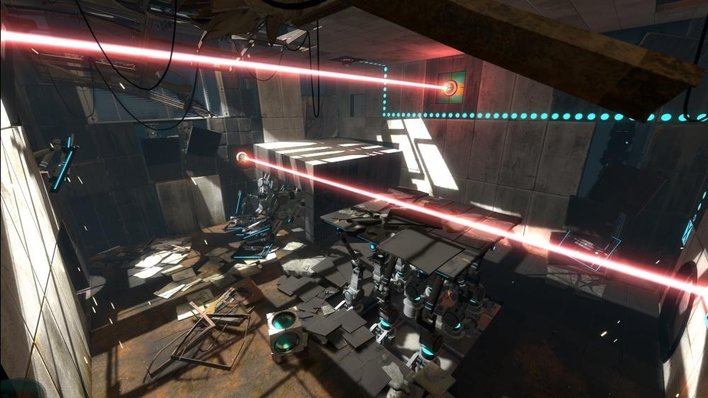
What is this I don't even... I can't even see the exit.
As in the first game, your Portal gun is your tool with which to complete the levels. In its most basic terms, it works by creating a doorway to another part of the level. You can only fire it against flat surfaces - walls, floors and the like - and even then, only against certain types of walls and floors. Fire one portal against a wall next to you, and another on a wall near a high up ledge, and you'll be able to walk through the portal, and come out on the hitherto inaccessible platform. Fire one on the ceiling, and one against the floor, and you'll find yourself plummeting for an eternity, as you drop through the floor, and come straight out the ceiling, ad infinitum. It's a pretty simple idea, but one that can be used in many different ways.
For most of the game, you'll simply be locked into a series of test chambers, where all you have to do is unlock the door, and reach the exit. Of course, this is a lot easier said than done - especially in a game as mind boggling as Portal. This is, first and foremost, a puzzle game, and working out what you've got to do, when, and where your portals are going to take you is the order of the day here. Whether you're activating switches that operate on timers, that require you to quickly run through a portal to the other side of the room, and push a switch before the timer ticks down; working out a way to bypass awkwardly placed walls that you can't stick portals to; redirecting lasers that you have to dodge, move, and manipulate, and, worst of all, avoiding the turrets that'll fire at you on sight, each test chamber's a veritable death trap - although that's kind of the point.
When it comes to solving puzzles, each element you come across in the game has many different uses, and it feels like no two chambers use the various parts in the same way. Take lasers, for example. Most lasers have to be directed so they fire into what we'll call a laser receptacle, until we can think of a better name, and can be redirected using a prism. Or, you can redirect them to set fire to turrets. It seems simple enough, until you start to redirect the laser using a prism, through a portal, into a another prism, before finally hitting the switch on the other side of the room, which triggers a second laser you have to direct to somewhere else. Every chamber you come to, every time you have to use the portals, you'll have to think things through, and use things in a completely different way.
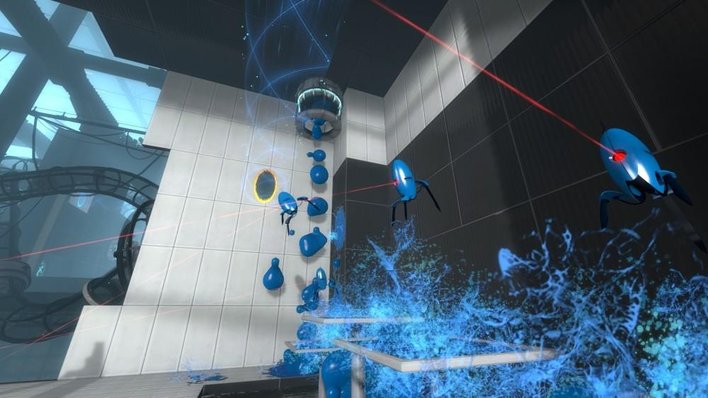
Anything the gel splatters becomes "bouncy". Like these turrets. Fun puzzles await.
Later in the game, you're introduced to repulsion gel, which effectively turns any surface into a giant trampoline. The first puzzle you come to is fairly simple, and all you've got to do is use your portal gun to redirect the goo that's pouring out of the dispenser to an area near a ledge, and then leap on the bouncy goo to reach the exit. Simple. But then, things quickly get a lot harder. One level sees you faced with a cube, which is suspended in the middle of a level from in a glass box, with a mesh roof. You need the cube to place on a switch, which opens a door, but you can't get into it - effectively, the cube's been imprisoned. [PUZZLE SPOILER - SKIP TO THE NEXT PARAGRAPH IF YOU WANT TO REMAIN SPOILER FREE] What you need to do is fire a portal below the repulsion gel dispenser, and one above the glass container, which coats the cube in the gel. Coated with the bouncy gel, it bounces off all of the walls like a mad thing, until it eventually smashes its way out of the cage. Hooray, you think - but now you've got another problem. Still coated in the goo, and still with plenty of momentum, the box is now flying around the inside of the room, bouncing off everything in sight. Luckily for you, next to the goo dispenser, there's a water dispenser, which keeps releasing giant streams of water - it's up to you to encourage it toward the cube, in order to calm it down...[/PUZZLE SPOILER]The trailers for the game promoted the idea that you had to start "thinking with portals", and it's certainly true - Portal 2 requires a completely different breed of thinking. With only two portals at your disposal, thinking inventively is the most important thing here. While a series of four of five portals could easily carry you to a platform you need to reach, with only two portals to play with, you'll often have to take a more round-about route. Gravity plays a key part in the levels too, and can be used to your advantage. Plant a portal up high, and a portal in the ground, and when you fall through it, you'll suddenly find yourself high up, approaching the ground, gaining momentum. Fire another portal below you as you approach the ground, and you'll be fired out of the portal in the air at great speed, letting you reach otherwise inaccessible platforms, buttons, and more. It's a weird way of doing things, as you'll need to approach each puzzle using real life logic, but taking into account Portal's game changer as you go.
For the duration of the single player mode, these elements come together to create a phenomenally clever game, that we can't possibly do justice to here without spoiling any more of the puzzles. It's also remarkably well balanced, and does a great job of introducing you to these incredibly foreign ideas. While veterans of the first game will pick things up quickly, there's certainly no requirement to have played it, and newbies will have few troubles getting stuck in here - in fact, the only place you might struggle picking things up is the story, which picks up where the first game left off.
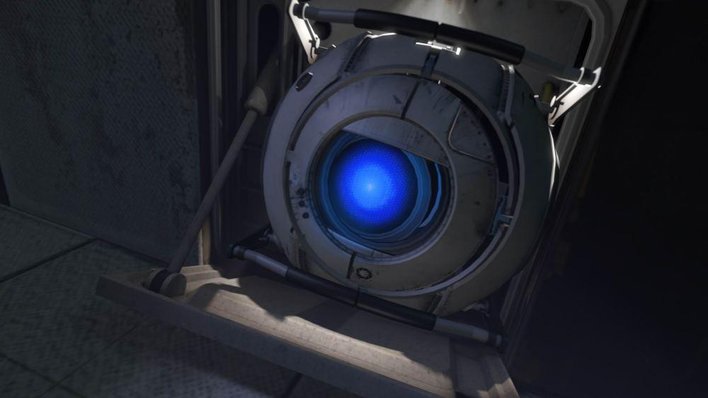
Wheatley's here to help you - we think...
If you haven't played the first game, a minor history lesson's needed here. In Portal, you played as the female protagonist, Chell, who found herself in a series of increasingly dangerous "test chambers", which had been designed as an elaborate way to see how much stress a human could take, and how resourceful you could be under pressure. You weren't meant to survive. Ran by the tyrannical, passive-aggressive sentient AI, GLaDOS on behalf of the Aperture Science company, you'd be "encouraged" by the genuinely funny GLaDOS, who rattled off witty one liners, and promised you cake upon completing the test (IT'S A LIE!). After apparently destroying GLaDOS at the end of the first game, and making a bid for freedom, you begin Portal 2 in captivity again, as a resident of the Aperture Science recouperation centre, which has gone into a bit of a melt down. With the world collapsing around you, you're saved by a small, nervous spherical robot called Wheatley, voiced by The Office writer, Stephen Merchant, who's attempting to save your life - because, with the main AI that was looking after the place now well and truly destroyed (by you), the place is, quite literally, falling apart. Being the nice guy that he is, the clumsy Wheatley's there to help you escape - at least, until he accidentally reactivates GLaDOS, and triggers a second round of Aperture Science "testing".
The thing is, Portal 2's almost as much fun to watch as it is to play, as the writing (and voice acting) is so good. It's one of the rare games that are actually genuinely funny, and in Portal 2, seeing the story slowly unravel is every bit as much fun as actually solving the puzzles yourself. Not that any second person would just be sitting there watching, anyway. In Portal 2, they can join in, too.
Brilliantly, Portal 2 comes complete with a full, entirely separate co-op mode, playable in either split screen, or online. With its own set of puzzles, its own protagonists, and subtly different gameplay mechanics, it may as well be an entirely different game - and having two minds working on the one puzzle doesn't necessarily make it easier, especially as the puzzles are now twice as hard. Getting your mind around how two portals are going to affect the level is difficult enough, but in co-op mode, you've now got four to think about, with two being controlled by a different person. Your progress through the levels is governed almost entirely by how well you can work with the other player as a team, as you really need each other if you want to get anywhere - but thankfully, things have been incredibly well thought through. With the ability to zoom in by pressing the right bumper, and set a marker for where you want your co-op partner to look and/or place a portal by pressing the left bumper, you don't have to rely on elaborate hand gestures and drawing maps on paper - which, would be somewhat hard, trying to take the portals into account. Still, it doesn't make the puzzles any easier.
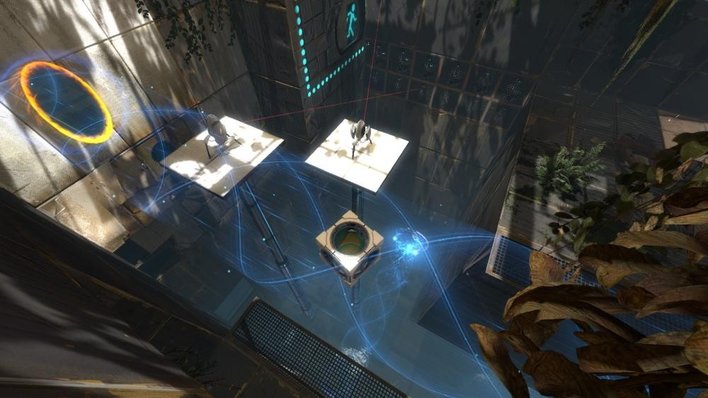
Portals, bridges, turrets, mirror cubs, and switches. This picture has it all.
If you've played the first game to death, then Portal 2 will be everything you could ever have hoped for - it's bigger, better, and, well, more Portal. In fact, about the only place where Portal 2 falls down is where it tries to do things differently. In the brief sections where you find yourself outside a test chamber (in the second half of the game), it can often be rather hard to figure out where you're meant to be going, yet alone spotting a wall you can stick a portal to. While there are a few hints (look for lights, as they usually show the way), there have been too many times we've sat around being not entirely sure where we're meant to be heading - and that's not the sort of puzzle we like to be solving.
Funnier than most other games, more intelligent than anything since Professor Layton, and with a pair of modes that somehow manage to be the same-yet-different, Portal 2 somehow manages to keep treading new ground. This is a game you'll want to own, a game you'll want to show your friends, and a game that can turn people onto gaming who've never considered playing a game that uses two analogue sticks before. While the game may make your mind melt, the decision about whether you should buy it's an easy one. Buy it. Get it. Love it.
Format Reviewed: Xbox 360


